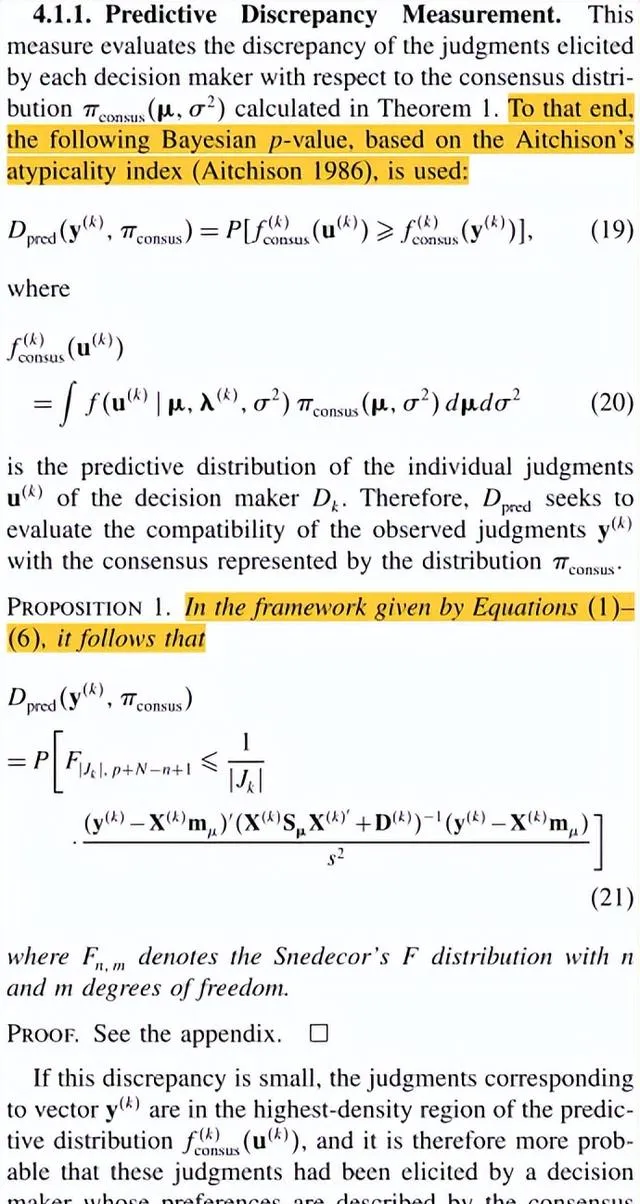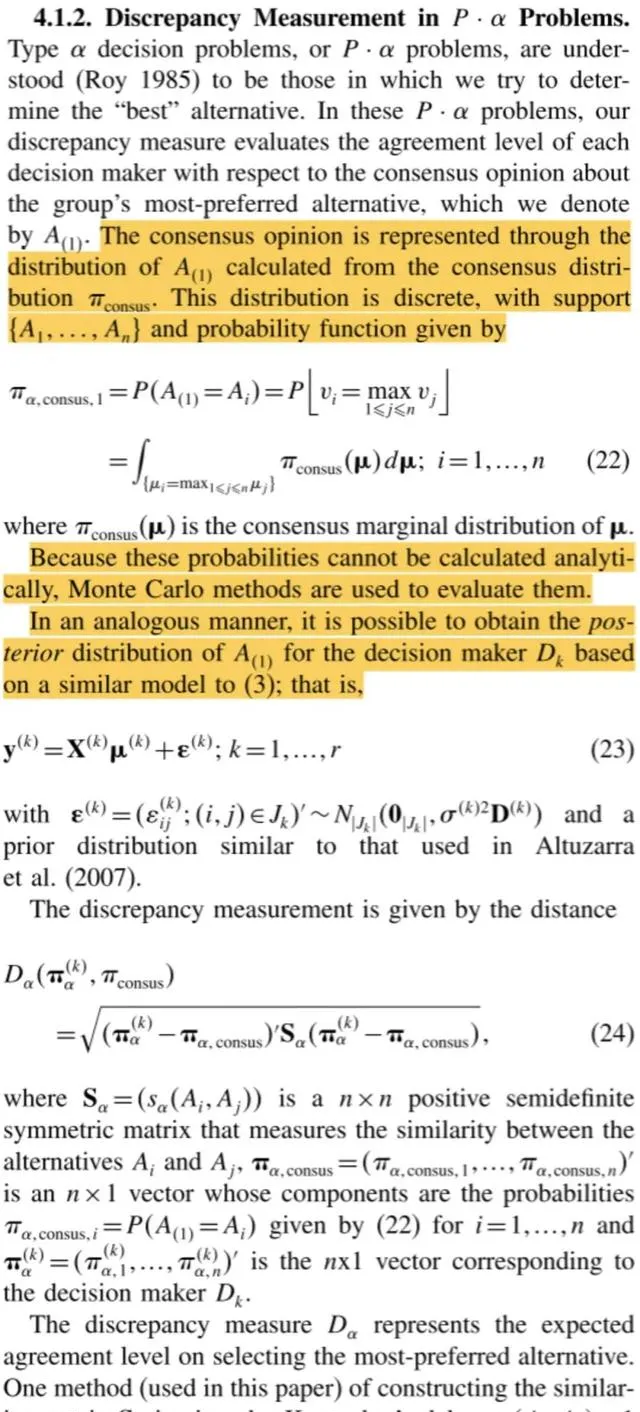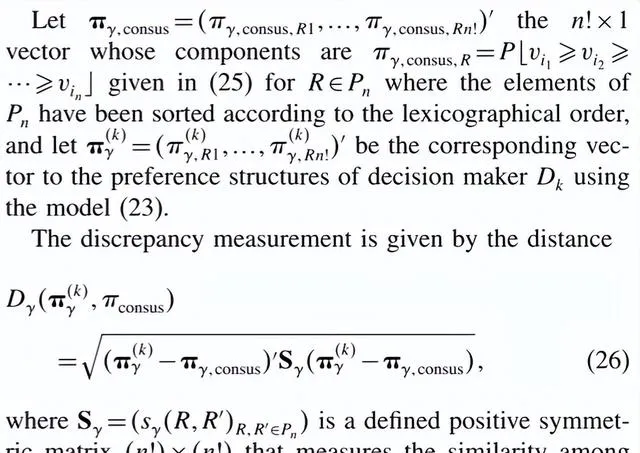
分享兴趣,传播快乐,
增长见闻,留下美好。
亲爱的您,这里是LearingYard学苑!
今天小编为您带来精读期刊论文【AHP群体决策中的一致性建立:贝叶斯方法】差异测量(1)。
欢迎您的访问!
Share interest, spread happiness,
increase knowledge, and leave beautiful.
Dear, this is the LearingYard Academy!
Today, the editor brings the "discrepancy Measurements (1) of the journal paper 'Consensus Building in AHP-Group Decision Making a Bayesian Approach' for abstract analysis".
Welcome to visit!
一、内容摘要(Summary of Content)
本期推文将从思维导图、精读内容、知识补充三个方面介绍精读期刊论文【确定多属性群决策协调权的模型和方法】的差异测量(1)。
This tweet will present the discrepancy Measurements (1) of the intensively read journal paper "Consensus Building in AHP-Group Decision Making a Bayesian Approach" in terms of mind mapping, intensive reading content, and knowledge supplementation.
二、思维导图(Mind Maps)

三、精读内容(Intensive reading content)
在第四章节中,作者将介绍一个建立共识的半自动程序。这种半自动的方法是在任何互动过程中寻求共识的前一步。该方法识别出不一致的行动者和判断,并在修改行动者的态度以达成共识时建立不同的共识路径。作者仅仅建立了一些共识路径,帮助决策者在谈判过程中固定他们的灵活性,但我们不能以封闭和确定性的方式确定最终的解决方案。
In Chapter 4, the author introduces a semi-automatic procedure for consensus-building. This semi-automatic approach is a step before seeking consensus in any interaction. The approach identifies inconsistent actors and judgments and establishes different consensus paths as the actor's attitudes are modified to reach consensus. The authors only establish some consensus paths to help decision makers fix their flexibility in the negotiation process, but we cannot determine the final solution in a closed and definitive way.
半自动程序由七个步骤组成,如下图所示。分别为:步骤1,问题公式化;步骤2,共识分布的演算;步骤3,不一致性测量;步骤4,不一致的行为者和判断;步骤5,结果分析;步骤6,寻求共识;步骤7,反馈阶段。
The semi-automatic program consists of seven steps, as shown in the figure below. They are as follows: Step 1, problem formulation; Step 2: Calculation of consensus distribution; Step 3, inconsistency measurement; Step 4, inconsistent actors and judgments; Step 5, result analysis; Step 6, seek consensus; Step 7, feedback phase.

(一)预测离散测量(Predictive discrete measurement)
该度量评估每个决策者得出的判断与定理1中计算的共识分布共识的差异,具体内容如下图所示。
This measure assesses the difference between the judgment reached by each decision maker and the consensus distribution consensus calculated in Theorem 1, as shown in the figure below.

(二)P·α问题中的离散度量(Discrete metrics in P·α problems)
P·α问题被理解为是试图确定「最佳」选择的问题。在这些问题中,差异度量评估了每个决策者对群体最偏好的选择的一致意见的一致程度,其具体内容如下。
The P·α problem is understood as one that attempts to determine the "best" choice. In these questions, the difference measure assesses the degree to which each decision maker agrees on the group's most preferred choice, as follows.

(三)P·γ问题中的离散度量(Discrete metrics in P·γ problems)
P·γ问题可以理解为试图确定最优选的排序或选择顺序的问题。在问题中,差异度量旨在评估每个决策者对群体偏好结构的一致意见的一致程度。共识意见是通过偏好排名分布来表示的,该分布是从共识分布计算出来的。该分布是离散的,具体内容如下。
The P·γ problem can be understood as a problem that attempts to determine the most preferred sort or order of selection. In the problem, the difference measure aims to assess the extent to which each decision maker agrees on the structure of group preferences. Consensus opinion is represented by a preference ranking distribution, which is calculated from the consensus distribution. The distribution is discrete, as follows.

同样地,这些概率无法通过分析计算,因此使用蒙特卡罗方法来评估它们。
Again, these probabilities cannot be calculated analytically, so the Monte Carlo method is used to evaluate them.

作者考虑到在P·α问题和P·γ问题问题中寻找差异度量,决定用与标积相关的欧几里得距离来表示它们,从而有利于使用多维标度(MDS)技术以图形和清晰的方式呈现决策者分布与共识分布之间存在的差异。
Considering the search for difference measures in the P·α problem and the P·γ problem, the authors decided to represent them in terms of Euclidean distances associated with the scale product, thus facilitating the use of multidimensional scaling (MDS) techniques to graphically and clearly present the differences between the decision-maker distribution and the consensus distribution.
四、知识补充——差异量数(Knowledge supplement - measure of difference)
差异量数亦称变异量数,又称离散趋势量数,它是统计学的基本概念之一,是表示样本数据偏离中间数值的趋势的量数,或者说它是反映样本频率分布离散程度的量数。
The measure of difference, also known as the measure of variance or the measure of discrete tendency, is one of the basic concepts of statistics. It is a measure that represents the tendency of sample data to deviate from the median value, or it is a measure that reflects the dispersion of the sample frequency distribution.
差异量数大,表示各数值分布的范围广且参差不齐;差异量数小,表示各数值较集中、整齐,波动的范围幅度小。因此,集中量数的代表性如何,可由差异量数反映。差异量数愈大,则集中量数的代表性愈小;差异量数愈小,则集中量数的代表性愈大。所以,考察某种分布的差异量数,有助于对集中量数的理解。
The difference quantity is large, indicating that the distribution range of each value is wide and uneven; The difference quantity is small, indicating that the values are more concentrated and neat, and the fluctuation range is small. Therefore, the representativeness of the concentrated measure can be reflected by the differential measure. The larger the difference measure, the smaller the representative of the concentrated measure. The smaller the differential measure, the greater the representative of the concentrated measure. Therefore, the study of the differential measure of a certain distribution is helpful to the understanding of the concentrated measure.
常见的差异量数有平均差、方差、标准差、全距、四分差、百分差等。
Common difference measures include mean difference, variance, standard deviation, range, quarter difference, percentage difference, etc.
今天的分享就到这里了,
如果您对文章有独特的想法,
欢迎给我们留言。
让我们相约明天,
祝您今天过得开心快乐!
That's all for today's sharing.
If you have a unique idea about the article,
please leave us a message,
and let us meet tomorrow.
I wish you a nice day!
参考资料:谷歌翻译、百度百科
参考文献:
Alfredo Altuzarra, José María Moreno-Jiménez, Manuel Salvador. Consensus building in AHP-group decision making: a Bayesian approach [J]. Operations Research, 2010, 58(6): 1755–1773.
本文由LearningYard学苑整理并发出,如有侵权请在后台留言!
文案| Ann
排版| Ann
审核| Zheng











